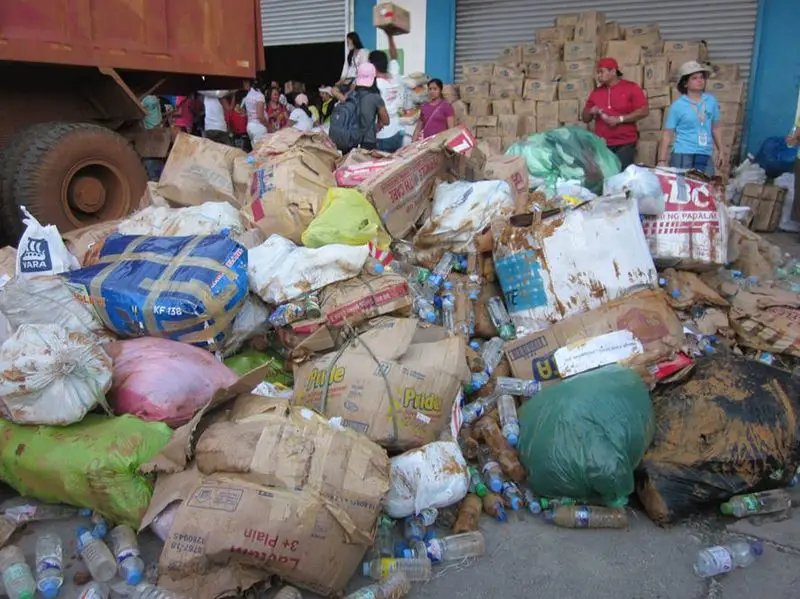It was not a government agency that delivered the first relief in Tacloban City and elsewhere. The Church organization Caritas has earned that distinction. On November 12th, the first relief items and food stocks arrived in Tacloban, and on the 14th, this was followed by shelter and sanitation materials. With the relief came 12 international Caritas members who volunteered to help in the distribution.[i]
How the group did it amidst the mountains of debris that blocked the city’s major thoroughfares and the seemingly insurmountable transportation problems, one can only surmise that they must have mobilized their own church network to get their goods moving and distributed to their target groups.
Aid for Eastern Samar, where Yolanda first made landfall, came days later – but only after its congressman Ben Evardone, made representations with other agencies involved in the relief operations. His story is worth telling if only because aid would have probably arrived several days later had he simply stood by and watched events unfold.
Evardone could not understand why there was delay in setting up a separate command center in his province when President Benigno Aquino III already approved it as early as, November 10, during his first visit to the first relief hub, Tacloban City in Leyte. The frustrated congressman had to travel back to Tacloban City on November 13, when no one was coming to set up the command center in Guiuan 3 days since Aquino approved of it. In the meantime, his constituents were growing hungrier every day and more desperate.
The first flight to Guiuan happened on Day 4, Monday, when Evardone, Gazmin, and Soliman flew in choppers to do reconnaissance flights to check areas beyond Tacloban City. Evardone asked the Philippine Air Force to fly him there on Sunday after the President's visit to Tacloban. There wasn't a flight for him.
They also had to check if the military C130s could land on Guiuan's World War 2 airport that has not been landed on for a long time. It was only then that Gazmin realized that Guiuan has an airport and a seaport that should have been tapped earlier to speed up aid delivery. On the same day, choppers made about 4 sorties carrying some relief goods.
To Evardone’s relief, the first C130 flights carrying relief goods landed the following day, Tuesday, five days after. Since then, C130s and choppers were flying sorties to Guiuan daily carrying up to 82,500 pounds a day.[ii]
Local officials
“The key element is that local officials should be the first to respond, but they themselves lost people. The local capacity on the ground should be doing a huge amount of work,” said United Nation for Humanitarian Affairs chief Valerie Amos.
“But that capacity was lost. We have to remember that even the mayor almost lost his wife. People are beside themselves looking for family members,” she added. Amos said they will be soon come up with an assessment of the situation, including the number of casualties and affected residents in the coming days. The UN has sent 100 people on the field while the United States sent about 90 marines to help in search-and-rescue efforts.
For its part, the Red Cross complained of security problems that hampered the distribution of relief goods. After all, one of their vehicles was looted by armed men near the San Juanico bridge connecting the two islands of Leyte and Samar. [iii]
Rotting goods, heartless relief workers
Unknown to many Yolanda victims who had yet to receive their first three kilos of rice and some canned goods, relief goods were starting to rot inside a DSWD repacking area in Tacloban as early as November 16th, eight days after the typhoon.
Blogger Ron Epiz describes in his article how the undistributed relief goods were rotting while the staff from the said agency were taking it easy, as if there was no widespread hunger in the city as well as its surrounding towns. He said he and his team volunteered to help in the repacking and distribution, and even volunteered their vehicle for distribution…only to be told “Pahinga muna kayo” (Get some rest). The rest lasted three precious hours before their services were finally utilized. His team had traveled for four hours, touring the towns of Leyte that were devastated and witnessing how people were going hungry because no help came.
There in the repacking area, he saw “bottled waters outside the warehouse spread like garbage, rice grains scattered like no one cares, relief boxes literally being dumped by trucks without thinking that whatever inside maybe damage, reliefs outside the warehouse soaked in the rains, and DSWD staff at the warehouse spending their day talking/chatting/seating while there are a lot of things need to be done ASAP.”
What irked him most was the attitude displayed by the DSWD personnel. They “pretended to be packing reliefs as soon as PNoy arrives at the packing area. I understand you are afraid of your boss, the President of the Republic of the Philippines. I have just lost respect on you because of what you did. When PNoy left, those staffs, the pretenders, stood up saying "Tara na! Wala na si boss!"[iv]
But his revelations would not be made public by the mass media. The ‘rotting goods’ issue would hug the headlines only months later.
(To be continued)
[ii] Fonbuena, Carmela, “First to suffer Yolanda's wrath, among last to get relief,” Published 8:00 AM, Nov 21, 2013, Rappler
[iii] Sara Susanne D. Fabunan , “UN exec frustrated over late assistance” Nov. 15, 2013, Manila Standard Today
[iv] “Typhoon Yolanda: DSWD Wasted and Rotting Relief Goods,” a blog of Ron Epiz with URL at: http://popularmanila.blogspot.com/2013/11/typhoon-yolanda-dswd-wasted-and-rotting.html, Tuesday, November 19, 2013



No comments:
Post a Comment